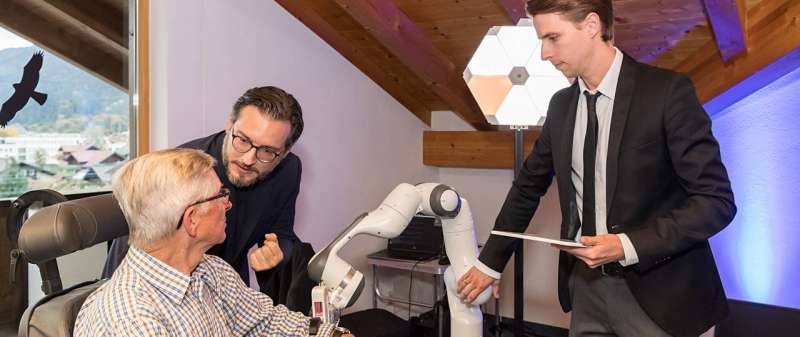
Reflexes protect our bodies—for example when we pull our hand back from a hot stove. These protective mechanisms could also be useful for robots. In this interview, Prof. Sami Haddadin and Johannes Kühn of the Munich School of Robotics and Machine Intelligence (MSRM) of the Technical University of Munich (TUM) explain why giving test subjects a ‘slap on the hand’ could lay the foundations for the robots of the future.
In your paper, published in Scientific Reports, you describe an experimental setup where people were actually slapped on the hand—to study their reflexes….
Kühn: Yes, you can put it that way. For our study, in cooperation with Imperial College London, the test subjects needed their reflexes to protect them against two different pain sources: first, a slap on the hand. And, while pulling their hand and arm out of harm’s way, they also had to avoid an elbow obstacle. We studied the hand retraction and discovered that it is a highly coordinated motion.
We also observed that the pain anticipated by a person shapes the reflex: If I know that the object behind me will cause similar pain to the slap on my fingers, I will withdraw my hand differently than when I know that the object will cause no pain.
How can such a seemingly simple experiment contribute to the development of intelligent high-tech machines like robots?
Haddadin: Humans have fascinating abilities. One could speak of a built-in intelligence in the human body that is indispensable for survival. The protective reflex is a central part of this. Imagine the classical “hand on the hot stove” situation. Without thinking, we pull back our hand as soon as the skin senses heat. So far, robots do not have reflexes of this kind. Their reactions to impending collisions tend to be rather mindless: They just stop and don’t move until a person takes action.
In some situations this might make sense. But if a robot simply stopped moving when touching a hot stove, this would obviously have fatal consequences. At the MSRM we are therefore interested in developing autonomous and intelligent reflex mechanisms as part of a central nervous system for robots, so to speak. Humans are serving as our role models. How do their reflexes work and what can we learn from them for the development of intelligent robots?
What conclusions can you draw from your experiment for the development of robots?
Kühn: We gained an insight into how the reflex motion works in detail: The way humans coordinate the reflex can be seen as throwing the shoulder forward, in a sense, in order to accelerate the withdrawal of the hand. This principle could be applied in the development of reflex motions in humanoid robots, with a signal sent to one part of a robot in order to influence the motion of another one.
This knowledge will also be helpful in the design of robot-enabled prosthetics that are expected to perform in “human-like” ways.
You mentioned that ‘anticipated pain’ played a role in your experiment. Should robots be able to anticipate pain, too?
Kühn: That would be a big advantage. It could help to classify potential collisions based on danger levels—and to plan evasive actions if appropriate. This would not only ensure the safety of the robot.
If the robot were capable of anticipating human pain, it could intervene in a dangerous situation to save a person from experiencing this pain.
Would robots then need to learn how to feel pain in the same way as humans?
Haddadin: No. Our pain perception is highly complex and linked to emotions. So we can’t compare this to a human’s “pain sensation.” Robots are tools and not living creatures. Artificial pain is nothing more than a technical signal based on data from various sensors. At the MSRM we have already developed an initial reflex mechanism for robots based on “artificial pain.” When touching hot or sharp objects, our robot withdrew its arm in a reflexive movement.
What are your next steps on the way to a robot with a fully developed protective reflex?
Haddadin: The big challenge in our research field between humans and machines is that we still have only a rudimentary understanding of our role model: the human reflex system, working with the sensorimotoric learning mechanisms of a complex, neuromechanical motion apparatus. And that is where the exciting scientific challenge lies: with all of the unknowns, to continually improve the human-inspired abilities of our intelligent machines, while using what we learn to arrive at a better understanding of how humans function. Basically, we can say that this has continued since the days of Leonardo Da Vinci and will carry on for many years to come.
Robots can be more aware of human co-workers, with system that provides context
Johannes Kühn et al, Arm movement adaptation to concurrent pain constraints, Scientific Reports (2021). DOI: 10.1038/s41598-021-86173-7
Citation:
Why robots need reflexes (2021, May 5)
retrieved 5 May 2021
from https://techxplore.com/news/2021-05-robots-reflexes.html
This document is subject to copyright. Apart from any fair dealing for the purpose of private study or research, no
part may be reproduced without the written permission. The content is provided for information purposes only.
Stay connected with us on social media platform for instant update click here to join our Twitter, & Facebook
We are now on Telegram. Click here to join our channel (@TechiUpdate) and stay updated with the latest Technology headlines.
For all the latest Technology News Click Here
For the latest news and updates, follow us on Google News.
